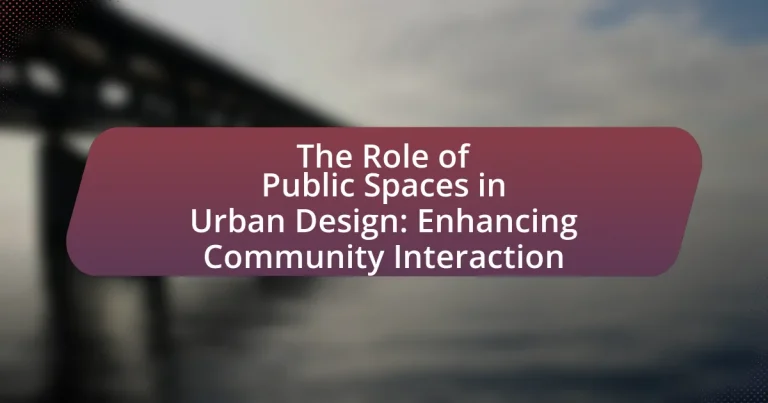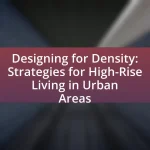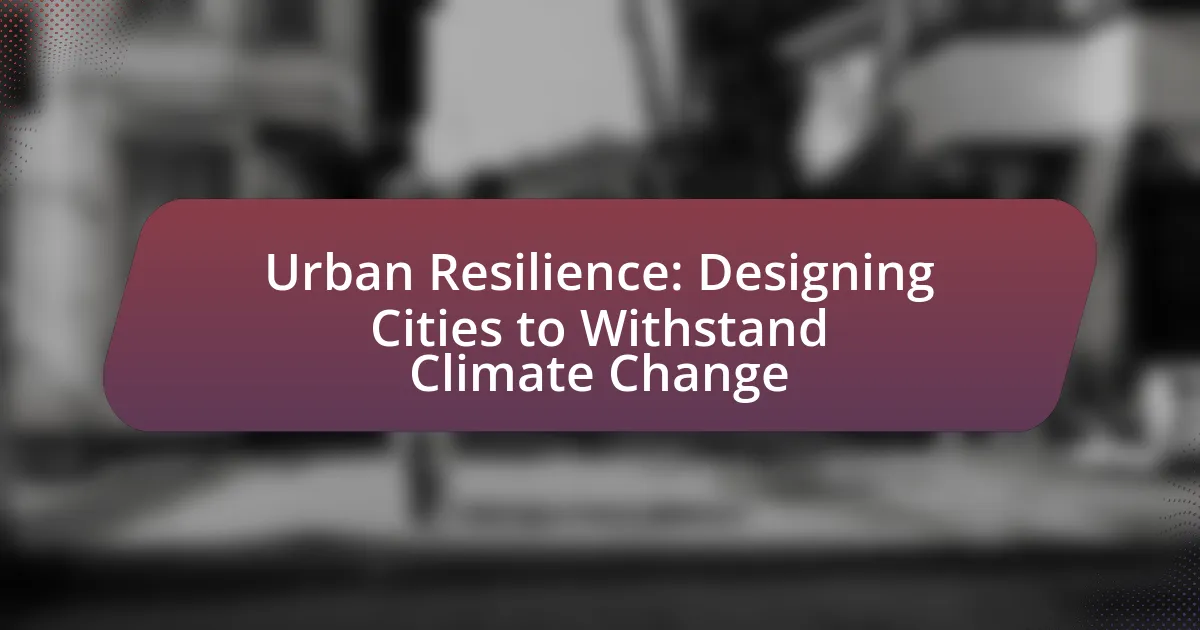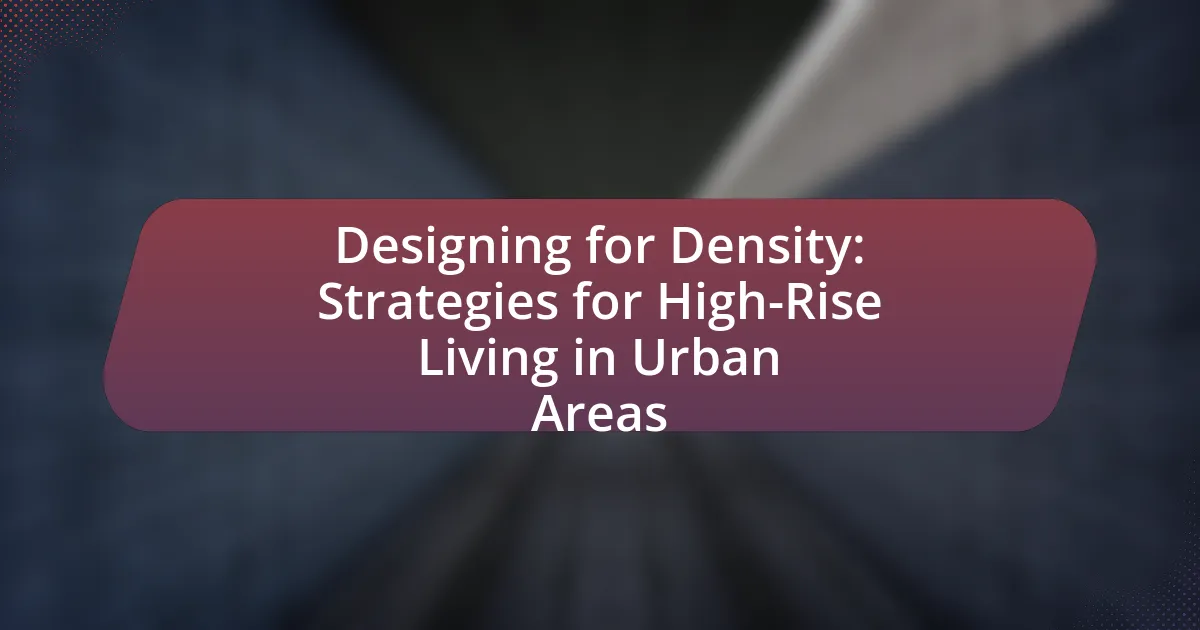Public spaces are essential components of urban design that significantly enhance community interaction and social cohesion. This article explores the various roles public spaces, such as parks and plazas, play in fostering social engagement, inclusivity, and overall quality of life in urban environments. It examines how design elements influence the use of these spaces, the social benefits they provide, and the challenges urban designers face in creating effective public areas. Additionally, the article highlights best practices for maintaining public spaces, innovative examples that promote community interaction, and the importance of community input in the design process.
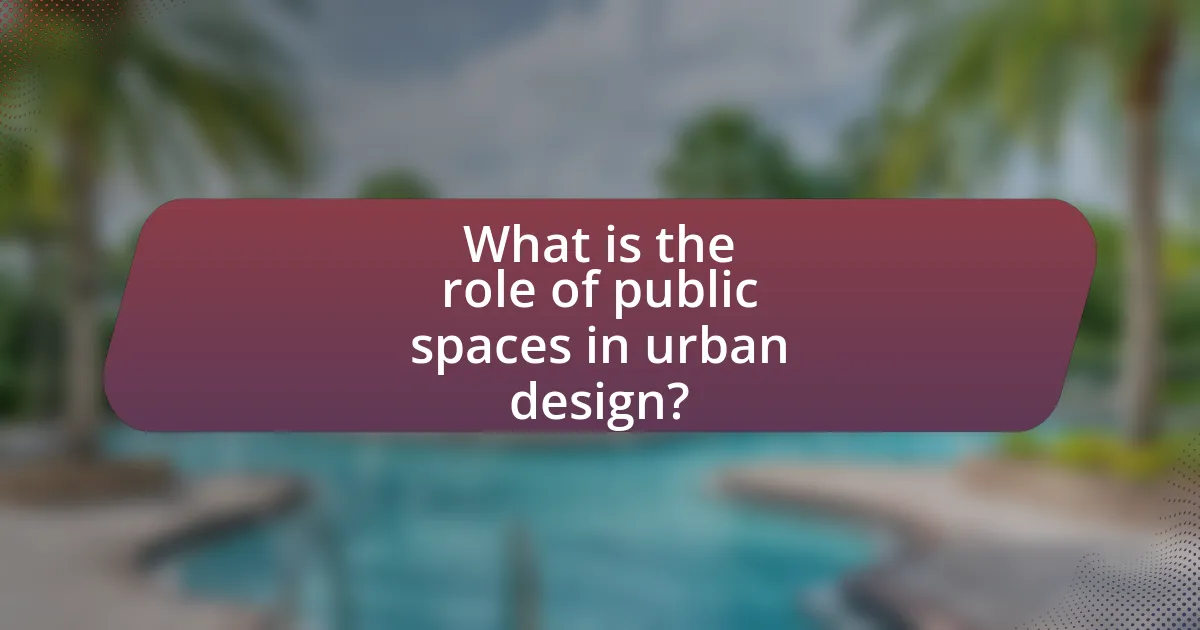
What is the role of public spaces in urban design?
Public spaces play a crucial role in urban design by fostering community interaction and enhancing social cohesion. These areas, such as parks, plazas, and streets, serve as venues for social gatherings, cultural events, and recreational activities, which contribute to the overall quality of urban life. Research indicates that well-designed public spaces can increase community engagement, reduce social isolation, and promote inclusivity, as evidenced by studies showing that cities with vibrant public spaces experience higher levels of social interaction among residents. For instance, a study published in the Journal of Urban Design found that public parks significantly improve community ties and encourage diverse social interactions, highlighting their importance in urban planning.
How do public spaces contribute to community interaction?
Public spaces enhance community interaction by providing accessible venues for social engagement and activities. These areas, such as parks, plazas, and community centers, serve as gathering spots where individuals can meet, share experiences, and participate in communal events. Research indicates that well-designed public spaces foster social cohesion; for instance, a study by the Project for Public Spaces found that vibrant public spaces increase the likelihood of community members interacting with one another, leading to stronger neighborhood ties. Additionally, public spaces often host events that encourage participation from diverse groups, further promoting inclusivity and interaction among community members.
What types of public spaces are most effective for fostering interaction?
Parks and plazas are the most effective types of public spaces for fostering interaction. These areas provide open environments that encourage social gatherings, recreational activities, and community events. Research indicates that parks with amenities such as seating, playgrounds, and walking paths significantly increase social interactions among community members. For example, a study published in the Journal of Urban Design found that well-designed public parks can enhance community cohesion by 30%, as they serve as venues for informal meetings and organized activities.
How do design elements influence the use of public spaces?
Design elements significantly influence the use of public spaces by shaping user experience, accessibility, and social interaction. For instance, the arrangement of seating, pathways, and landscaping can encourage people to gather, relax, or engage in activities. Research by Gehl Architects highlights that well-designed public spaces, which incorporate elements like greenery, seating, and open areas, can increase foot traffic by up to 40%, fostering community interaction. Additionally, elements such as lighting and signage enhance safety and navigation, further promoting the use of these spaces.
Why are public spaces essential for urban environments?
Public spaces are essential for urban environments because they foster community interaction and social cohesion. These areas provide a venue for people to gather, engage in recreational activities, and participate in cultural events, which enhances the overall quality of life. Research indicates that cities with well-designed public spaces experience increased social interactions, leading to stronger community ties and improved mental well-being. For instance, a study by Project for Public Spaces found that vibrant public spaces can increase local economic activity by up to 20%, demonstrating their significant impact on urban vitality.
What social benefits do public spaces provide to communities?
Public spaces provide essential social benefits to communities by fostering interaction, inclusivity, and a sense of belonging. These areas serve as venues for social gatherings, cultural events, and recreational activities, which enhance community cohesion. Research indicates that well-designed public spaces can increase social interactions by up to 50%, as they encourage people from diverse backgrounds to come together. Furthermore, studies show that access to public spaces is linked to improved mental health and well-being, as they offer opportunities for relaxation and social engagement.
How do public spaces impact mental health and well-being?
Public spaces significantly enhance mental health and well-being by providing environments that promote social interaction, physical activity, and relaxation. Research indicates that access to green spaces, such as parks, can reduce stress and anxiety levels, as evidenced by a study published in the journal “Environmental Science & Technology,” which found that individuals living near green spaces reported better mental health outcomes. Furthermore, public spaces facilitate community engagement, fostering a sense of belonging and support, which are crucial for psychological well-being. The presence of well-designed public areas encourages outdoor activities, contributing to improved physical health, which is closely linked to mental health.
What challenges do urban designers face in creating effective public spaces?
Urban designers face several challenges in creating effective public spaces, including balancing diverse community needs, managing limited budgets, and addressing environmental sustainability. These challenges arise because public spaces must cater to various user groups with differing preferences and requirements, making it difficult to create universally appealing designs. Additionally, financial constraints often limit the scope of projects, forcing designers to prioritize certain features over others. Environmental considerations, such as climate resilience and ecological impact, further complicate the design process, as urban designers must integrate sustainable practices while ensuring functionality and aesthetic appeal.
How can urban planners address issues of accessibility in public spaces?
Urban planners can address issues of accessibility in public spaces by implementing universal design principles that ensure all individuals, regardless of ability, can navigate and utilize these areas effectively. This includes features such as wheelchair ramps, tactile paving for the visually impaired, and clear signage that accommodates various languages and literacy levels. Research indicates that cities employing these principles see increased usage of public spaces by diverse populations, enhancing community interaction and cohesion. For instance, the American with Disabilities Act (ADA) sets standards that have been shown to improve accessibility, leading to a 20% increase in public space utilization in compliant areas.
What role does community input play in the design of public spaces?
Community input is essential in the design of public spaces as it ensures that these areas meet the actual needs and preferences of the users. Engaging local residents in the planning process leads to spaces that reflect the community’s identity, culture, and values, fostering a sense of ownership and belonging. Research by the Project for Public Spaces indicates that public spaces designed with community involvement are more likely to be utilized and maintained, resulting in higher levels of social interaction and satisfaction among users. This collaborative approach not only enhances the functionality of the space but also promotes inclusivity and accessibility, making public areas more welcoming for diverse populations.
How can public spaces be designed to enhance community interaction?
Public spaces can be designed to enhance community interaction by incorporating features that promote accessibility, inclusivity, and engagement. For instance, creating open areas with seating, greenery, and pathways encourages social gatherings and informal interactions among community members. Research indicates that well-designed public spaces, such as parks and plazas, can increase social cohesion; a study by Project for Public Spaces found that vibrant public spaces lead to a 20% increase in community engagement. Additionally, integrating amenities like playgrounds, sports facilities, and event spaces fosters diverse activities, attracting various demographics and facilitating connections.
What design strategies promote inclusivity in public spaces?
Design strategies that promote inclusivity in public spaces include universal design, multi-sensory environments, and flexible layouts. Universal design ensures accessibility for individuals with varying abilities by incorporating features such as ramps, tactile surfaces, and clear signage. Multi-sensory environments engage different senses, catering to diverse needs and preferences, which can enhance the experience for all users. Flexible layouts allow for adaptable use of space, accommodating various activities and community events, thereby fostering interaction among diverse groups. Research indicates that inclusive design not only improves usability but also enhances social cohesion, as seen in studies conducted by the Center for Inclusive Design and Environmental Access, which highlight the positive impact of these strategies on community engagement.
How can technology be integrated into public spaces to improve interaction?
Technology can be integrated into public spaces to improve interaction by implementing interactive kiosks, free Wi-Fi, and augmented reality applications. Interactive kiosks provide information and services, facilitating communication between users and local businesses or city services. Free Wi-Fi encourages social connectivity and allows users to engage with digital platforms while in public spaces. Augmented reality applications can enhance the experience by providing historical context or interactive features that encourage exploration and engagement with the environment. These integrations have been shown to increase foot traffic and community engagement, as evidenced by studies indicating that public spaces with technological enhancements see a 30% increase in visitor interaction.
What are the best practices for maintaining public spaces?
The best practices for maintaining public spaces include regular cleaning, landscaping, infrastructure upkeep, community engagement, and safety measures. Regular cleaning ensures that areas remain free of litter and debris, which enhances aesthetic appeal and encourages usage. Landscaping, such as planting trees and flowers, contributes to environmental health and visual attractiveness. Infrastructure upkeep, including repairing benches, pathways, and lighting, ensures safety and accessibility for all users. Community engagement involves involving local residents in decision-making and maintenance efforts, fostering a sense of ownership and responsibility. Implementing safety measures, such as adequate lighting and surveillance, enhances the security of public spaces, making them more inviting. These practices collectively contribute to the sustainability and functionality of public spaces, promoting community interaction and well-being.
How can communities engage in the upkeep of public spaces?
Communities can engage in the upkeep of public spaces through organized volunteer efforts, such as clean-up days and maintenance workshops. These initiatives foster a sense of ownership and responsibility among residents, leading to improved conditions in parks and communal areas. Research indicates that neighborhoods with active community involvement in public space maintenance report higher satisfaction levels and increased usage of these areas, as seen in studies conducted by the Project for Public Spaces, which highlight the positive correlation between community engagement and the quality of public spaces.
What role do local governments play in the maintenance of public spaces?
Local governments are responsible for the maintenance of public spaces, ensuring they are clean, safe, and accessible for community use. This includes regular upkeep such as landscaping, trash collection, and infrastructure repairs, which contribute to the overall quality of life in urban areas. For instance, a study by the National Recreation and Park Association indicates that well-maintained parks can increase community engagement and promote social interaction, highlighting the importance of local government involvement in these spaces.
What innovative examples of public spaces enhance community interaction?
Innovative examples of public spaces that enhance community interaction include community gardens, pop-up parks, and multifunctional plazas. Community gardens foster collaboration among residents, allowing them to cultivate plants together, share resources, and build relationships, which has been shown to improve social cohesion. Pop-up parks, often created in underutilized urban areas, provide temporary green spaces that encourage social gatherings and recreational activities, effectively transforming the urban landscape and promoting community engagement. Multifunctional plazas serve as versatile venues for events, markets, and performances, facilitating diverse interactions among community members and enhancing local culture. These examples demonstrate how thoughtfully designed public spaces can significantly improve community interaction and strengthen social ties.
How have successful public spaces transformed urban areas?
Successful public spaces have transformed urban areas by fostering community interaction and enhancing social cohesion. These spaces, such as parks, plazas, and community centers, serve as vital hubs where residents gather, engage in recreational activities, and participate in cultural events. For instance, a study by Project for Public Spaces highlights that well-designed public spaces can increase foot traffic by up to 40%, leading to greater economic activity and local business growth. Additionally, cities like Copenhagen have seen a significant reduction in traffic congestion and pollution due to the promotion of pedestrian-friendly public areas, demonstrating the positive impact on urban mobility and environmental sustainability.
What lessons can be learned from global examples of effective public spaces?
Global examples of effective public spaces demonstrate the importance of accessibility, inclusivity, and multifunctionality in urban design. For instance, the High Line in New York City transformed an abandoned railway into a vibrant park, promoting community interaction and economic revitalization. Studies show that such spaces can increase foot traffic by up to 30%, enhancing local businesses. Additionally, the success of Barcelona’s Superblocks initiative illustrates how prioritizing pedestrian areas can reduce traffic congestion and improve air quality, leading to healthier urban environments. These examples highlight that well-designed public spaces foster social connections, support local economies, and contribute to overall urban sustainability.
How can communities advocate for better public spaces?
Communities can advocate for better public spaces by organizing collective efforts to voice their needs and preferences to local government and stakeholders. This can include forming advocacy groups, conducting surveys to gather community input, and presenting proposals for improvements at town hall meetings. Research indicates that community engagement in urban design leads to more effective and inclusive public spaces, as seen in the Project for Public Spaces, which emphasizes the importance of local input in creating vibrant public areas.
